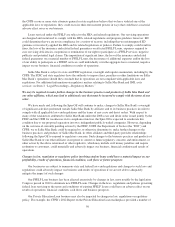Sallie Mae 2013 Annual Report Download - page 46
Download and view the complete annual report
Please find page 46 of the 2013 Sallie Mae annual report below. You can navigate through the pages in the report by either clicking on the pages listed below, or by using the keyword search tool below to find specific information within the annual report.Federal funding constraints and spending policy changes triggered by associated federal spending deadlines
may result in disruption of federal payments for services we provide to the government, which could materially
and adversely affect our business strategy or future business prospects.
We receive payments from the federal government on our FFELP Loan portfolio and for other services we
provide to them, including servicing loans under the DSLP and providing default aversion and contingency
collections to ED. Payments for these services may be affected by various factors, including the following:
•The Bipartisan Budget Act enacted on December 26, 2013, includes several provisions that will have or
could have an effect on our business. First, the Act reduced the amount paid to guaranty agencies for
defaulted FFELP Loans rehabilitated under Section 428F of the HEA, beginning on July 1, 2014. See the
section titled “Business Services Segment” in Item 1. “Business” for a discussion on the potential impact
of the Budget Act on future operations. In addition, the Budget Act eliminated funding for the direct loan
servicing performed by not-for-profit servicers. The Budget Act requires that all servicing funding be
provided through the annual appropriations process which is subject to certain limitations. Although the
payments for our direct loan servicing contract is already funded from annual appropriations, the
requirement to fund all servicing from the limited appropriated funding could have an effect on our future
business in ways we cannot predict at this time.
•Other Higher Education Legislation: As Congress considers the reauthorization of the HEA, it could
consider legislation that would reduce the payments to Guarantors or change the consolidation program to
incentivize student loan borrowers to refinance their existing student loans, both private and federal. Such
reforms could reduce our cash flows from servicing and interest income as well as its net interest margin.
It is possible that the Administration and Congress in the future could engage in a prolonged debate linking
the federal deficit, debt ceiling and other budget issues resulting in a similar debate to the one that occurred
around the Budget Control Act of 2011 and the raising of the debt ceiling in October 2013. If U.S. lawmakers in
the future fail to reach agreement on these issues, the federal government could stop or delay payment on its
obligations, including those on services we provide. We cannot predict how or what programs will be impacted
by any actions that the Administration, Congress or the federal government may take. Further, legislation to
address the federal deficit and spending could include proposals that would adversely affect FFELP and DSLP-
related servicing businesses. A protracted reduction, suspension or cancellation of the demand for the services we
provide, or proposed changes to the terms or pricing of services provided under existing contracts with the
federal government, including our contract with ED, could have a material adverse effect on our revenues, cash
flows, profitability and business outlook, and, as a result, could materially adversely affect our business, financial
condition and results of operations.
We continue to undertake numerous cost-cutting initiatives to realign and restructure our business in light of
significant legislative changes in the past several years and the amortization of the FFELP Loan portfolios we
service. Our business, results of operations and financial condition could be adversely affected if we do not
effectively align our cost structure with our current business operations, regulatory compliance obligations
and future business prospects.
In response to significant legislative changes in the past several years, including the end of FFELP, we have
undertaken and continue to undertake cost-cutting initiatives, including workforce reductions, servicing center
closures, restructuring and transfers of business functions to new locations, enhancements to our web-based
customer services, adoption of new procurement strategies and investments in operational efficiencies. Our
business and financial condition could be adversely affected by these cost-cutting initiatives if cost reductions
taken are so dramatic as to cause disruptions in our business, reductions in the quality of the services we provide
or cause us to fail to comply with applicable regulatory standards. We may be unable to successfully execute on
44
























